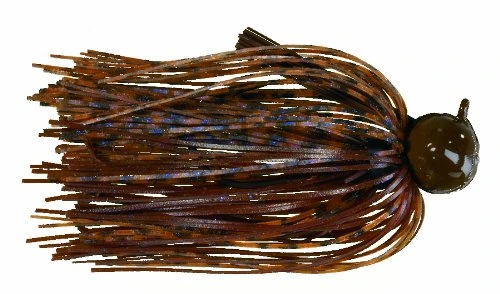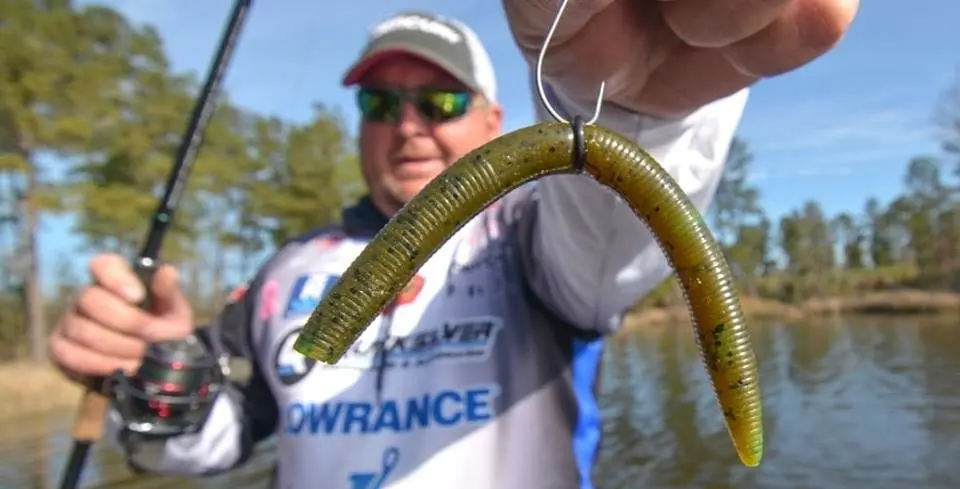3 Best Winter Bass Baits

Winter is when trophy hunters shine. Across the country, more monster largemouth are caught in cold water than any other time of year. When water temps plunge into the 40s, bass fishing becomes a game of patience and precision—but the payoff can be the fish of a lifetime.
I’ve narrowed down the three most productive cold-water baits that consistently produce big bites when the bite gets tough. These aren’t trendy lures or gimmicks—they’re proven weapons that belong in every serious bass angler’s winter arsenal.
1. Suspending Hard Jerkbaits
When water temperatures drop into the 40s and below, suspending jerkbaits become absolutely lethal. The key is finding baits that hang perfectly in the strike zone—models like the LuckyCraft Pointer, Duo Realis Jerkbait, Megabass Vision 110, and the classic Rapala Husky Jerk are all tournament-proven fish catchers.

Custom Painted LuckyCraft Pointer
Why jerkbaits dominate in winter:
- They perfectly mimic dying or stunned baitfish
- The erratic, darting action triggers aggressive reaction strikes from lethargic bass
- The suspend feature keeps the bait in the strike zone longer, giving cold-water bass time to commit
Where to throw them: Target deep water docks, bluff walls, creek channel swings, secondary points, and any remaining green weed lines. These are all places where bass stage in winter waiting to ambush baitfish.
How to fish them: The cadence is critical. Twitch, twitch, pause. Twitch, twitch, pause. The colder the water, the longer you need to let it hang motionless. Sometimes a 10-15 second pause is what separates you from everyone else. I know it feels like an eternity, but that’s when the big girls eat.
Pro Tip: Match your jerkbait color to local baitfish. In stained water, go with chartreuse or firetiger. In clear water, stick with natural shad patterns or ghost colors.
2. Jigs – The Cold Water King
If I could only throw one bait all winter long, it would be a jig. Period. While bass metabolism slows down dramatically in cold water, crawfish remain active and provide the high-protein meal that big bass are looking for as they prepare for the spawn.

Football jig rigged for winter bass
Prime winter jig locations:
- Laydowns and fallen timber
- Chunk rock, boulders, and rip-rap
- Creek channel edges and ledges
- Deep points with hard bottom structure
- Shallow remaining vegetation (yes, shallow can still produce!)
Winter jig presentation: Slow it way down. I’m talking painfully slow drags and long pauses. Use a subtle trailer like a Reaction Innovations Sweet Beaver (don’t split the tail), Zoom Super Chunk, or even a crawfish-style trailer with minimal action. You want the jig to look like an easy, cold-blooded meal.

Reaction Innovations Sweet Beaver trailer
Jig selection: A 3/8 to 1/2 oz football jig in green pumpkin, black and blue, or PB&J works in most situations. In stained water or low-light conditions, add some chartreuse or orange to the skirt.
Pro Tip: Don’t set the hook on the initial thump. Cold-water bass often just grab the trailer. Wait until you feel the weight of the fish before driving the hook home.
3. Weightless Sinking Worm – The Stealth Assassin
The weightless worm is the most underrated winter technique, period. With light line and patience, you can get this bait as deep as 40+ feet, right where suspended bass are waiting. The slow, spiraling fall is irresistible to big fish, and the stealthy presentation means you can work the same area multiple times without spooking them.

Weightless stick worm setup
Best worms for winter: Yamamoto Senko (5"), Gary Yamamoto Swim Senko, Zoom Trick Worm, or any straight-tail stick bait in 4-6" sizes. Natural colors like green pumpkin, watermelon, and junebug work great, but don’t sleep on white or pearl in ultra-clear water.
Where to fish it:
- Winter flats with scattered grass where bass chase baitfish
- Deep points and secondary points 30-40 feet deep where bass suspend over big balls of shad
- Deep docks positioned on creek channels
- Transition zones where shallow flats drop into deeper water
The technique: This is where patience pays huge dividends. Use 6-8 lb fluorocarbon on a spinning rod and let the worm sink on complete slack line. Count it down. In 40 feet of water, you might be counting for 2-3 minutes before it reaches the fish. Watch your line like a hawk—bites are often just a slight tick or the line moving sideways.
Cold-water bass are less aggressive, so the light line and natural action give them confidence to commit. When you get bit, reel down slowly until you feel weight, then sweep the rod to set the hook.
Pro Tip: Add a small nail weight (1/16 oz) to the head of the worm to get it down faster in really deep water or windy conditions. It still maintains that critical slow fall.
Final Thoughts: Slow Down and Cash In
Winter bass fishing is a mental game as much as a physical one. The fish are there, they’re bigger than summer fish, and they’re willing to bite—but only if you slow everything down and put your bait exactly where they’re living.
Master these three baits, fish them with confidence in the right locations, and you’ll catch some of the biggest bass of your life when everyone else has put their rods away for the season.
Tight lines and bundle up out there!
@ksbigbass
